
- Homepage
- Material
- Metal
- Origin
- Style
- Antique (22)
- Antiquity (26)
- Antiquité (89)
- Art Deco (95)
- Art Nouveau (65)
- Bangle (31)
- Boucle (35)
- Bracelet (20)
- Chain (27)
- Cuff (20)
- Jonc (19)
- Louis Philippe (15)
- Louis Xvi (78)
- Manchette (20)
- Napoleon Iii (110)
- Napoléon Iii (207)
- Napoléon, Empire (44)
- Restauration (19)
- Xixe (22)
- 1900 (15)
- Other (3309)
- Sub-type
- Type
- Bague Sertie (96)
- Bijou (89)
- Bracelet (13)
- Café, Thé (16)
- Chain (12)
- Christianisme (47)
- Christianity (39)
- Jewelry (30)
- Montre De Poche (29)
- Montre à Gousset (20)
- Objet De Métier (28)
- Pendant (14)
- Pendantes (34)
- Pendentif (27)
- Ring (17)
- Sautoir (28)
- Set Ring (37)
- Tableware, Cooking (11)
- Tableware, Cuisine (92)
- Tableware, Kitchen (56)
- Other (3553)
Antique ring, talisman, Silver, Unique, magic square, Africa
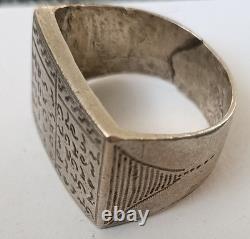
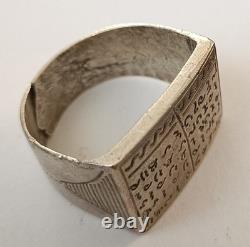
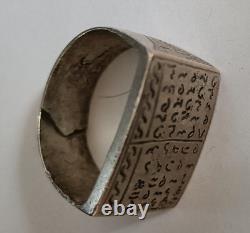
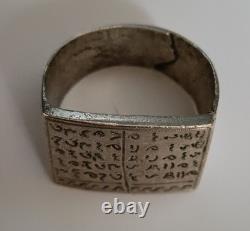

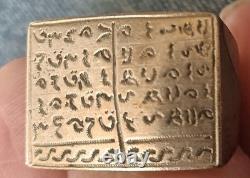
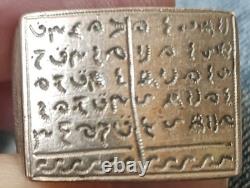


The inscription on this ring exhibits characteristics that very likely connect it to the traditions of magical amulets or talismans found in Africa, particularly in West and East Africa, often with Islamic influences. Here is an analysis of the visible elements. The face of the ring is rectangular and divided by a vertical line, reminiscent of the format of magic squares or talismanic tables (sometimes referred to as gris-gris or gri-gri in West Africa). This type of format is very common on rings and amulets intended to provide protection or a blessing to their wearer. The engraved writing is not a common alphabet easily identifiable as classical Arabic or Tifinagh (the script of the Tuaregs), but it is very similar to a type of encryption, esoteric script, or magical symbols used in Islamic and syncretic contexts in Africa.
The characters are highly stylized, curved, and sometimes barely recognizable. This type of writing is often used for mystical reasons and can represent: Modified and combined Arabic numbers or letters, as evidenced in the symbolic repertoire of Ethiopian rings that use Eastern Arabic numerals and Arabic letters. Coded symbols or ciphers whose meaning is known only to the artisan or a marabout/talisman specialist, who engraves them for a specific magical intention.
Glyphs or traditional talismanic signs with no direct link to a known linguistic alphabet, but which possess their own symbolic and protective power. In the context of African talismanic art, a ring with such inscriptions is almost always designed as a protective amulet. These rings are believed to provide protection to the wearer against the evil eye, diseases, bad luck, or malevolent spirits. They may also be intended to attract fortune, success, luck, or to heal ailments. The Tradition of the "Seal of Solomon.
" Many magical traditions in Africa and the Middle East are influenced by the legend of the "Seal of Solomon" (or Ring of Solomon). This seal was said to be engraved with the "greatest name" of God and to give Solomon power over spirits. Talismanic rings often embrace the idea of powerful symbols conferring magical power. This ring is very likely a talismanic ring or amulet of African origin.
The writing is an esoteric script or a set of magical symbols (a "cipher") engraved not to be read, but to serve as protection, charm, or blessing for its wearer, rooted in local mystical traditions, potentially influenced by Islamic esotericism. It is nearly impossible to translate this script literally without a deep knowledge of the precise symbolic repertoire of the region or the cultural tradition from which the ring originates.

